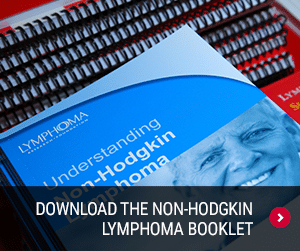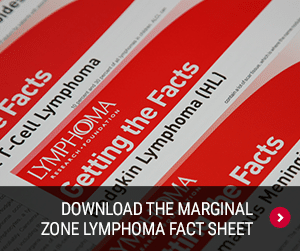
What is Lymphoma?
Marginal Zone Lymphoma: Treatment Options
Treatment selection for a patient with Marginal Zone Lymphoma (MZL) depends on the type, the stage and location of the disease, the patient’s age and overall health, and any lymphoma-related signs or symptoms.
Treatment for Gastric MALT
Since gastric MALT lymphoma is often the result of an infection with H. pylori, the initial treatment is antibiotic therapy, usually combined with proton pump inhibitors (PPIs), which is typically given for two weeks. PPIs reduce the production of stomach acid to help prevent or heal ulcers. In about 90 percent of cases, these lymphomas go away following antibiotic and PPI treatment, although this may take several months. Most gastric MALT lymphomas are low-grade lesions that grow slowly and do not tend to spread to other places in the body. If the lymphoma relapses (disease returns after treatment) or becomes refractory (disease does not respond to treatment) after antibiotic therapy, there are many additional treatment options available, including rituximab (Rituxan), radiation therapy, and surgery.
Treatment for Non-Gastric MALT
Non-gastric MALT can appear in a variety of areas throughout the body. Therefore, treatment is usually based on the exact location and extent of spread. Physicians may defer treatment until symptoms appear, an approach called “watch and wait” or “watchful waiting.” With this strategy, patients’ overall health and disease are monitored through regular checkup visits and various evaluating procedures, such as laboratory and imaging tests. Active treatment is started if the patient begins to develop lymphoma-related symptoms or there are signs that the disease is progressing based on testing during followup visits. When necessary, treatment typically includes surgery for certain sites (lung, breast) or radiation therapy. More advanced disease is usually treated with immunotherapy and chemotherapy. Common initial treatments are bendamustine (Treanda) plus rituximab and R-CHOP (rituximab, cyclophosphamide, doxorubicin, vincristine, and prednisone), which are used to treat other slow growing lymphomas such as follicular lymphoma. Antibiotic therapy such as doxycycline has been shown to be effective in MZL that affects the area around the eye (ocular adnexal lymphoma), which has been associated with infection.
Treatments Nodal MZL
Since nodal MZL is most often a slow-growing disease, physicians may adopt an approach often referred to as active surveillance (i.e. watch and wait) until symptoms appear. When treatment is necessary, options include radiation therapy, chemotherapy and/or immunotherapy, and other treatments commonly used in other types of slow-growing lymphomas, such as follicular lymphoma.
Treatment for Splenic MZL
Treatment is not always immediately necessary for splenic MZL Treatment. When treatment is deemed appropriate, several options exist. Some patients may receive a splenectomy (surgical removal of the spleen); patients ineligible for surgery may receive low-dose radiation of the spleen. Other patients may be given rituximab, a monoclonal antibody, with or without chemotherapy. In some cases, because of the association of this type of lymphoma with HCV, interferon with or without antiviral therapy may be given to patients who show evidence of HCV infection.
To learn about treatments under investigation for Marginal Zone Lymphoma, download the Marginal Zone Lymphoma Fact Sheet.


